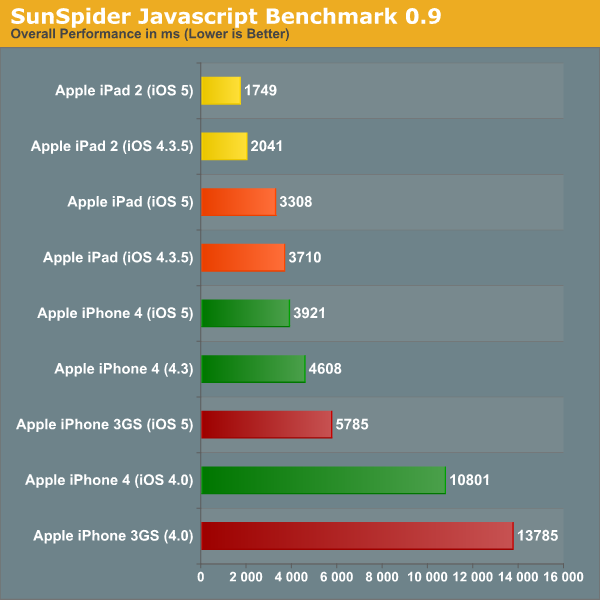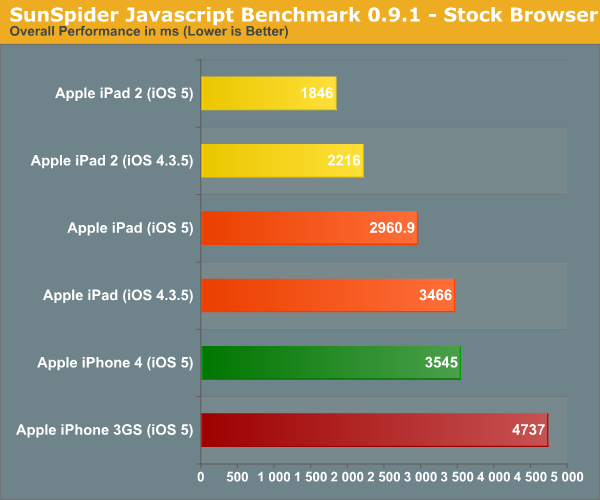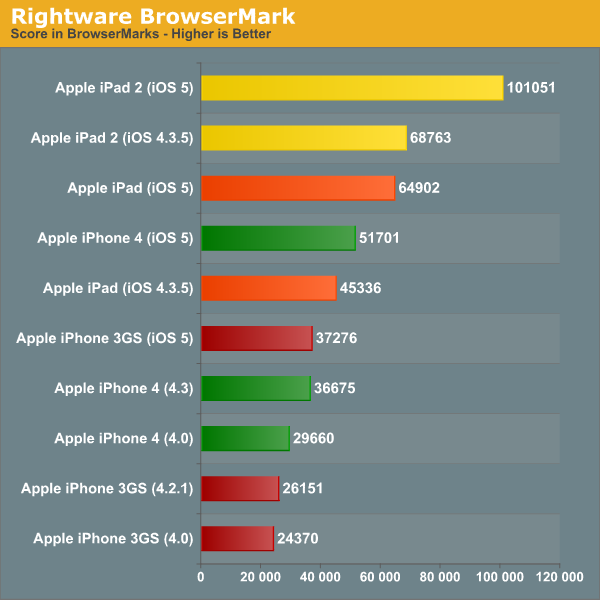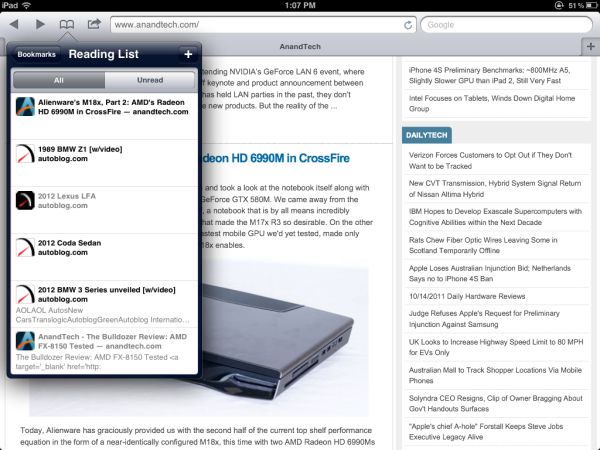Apple iOS 5 Review
by Vivek Gowri, Andrew Cunningham, Saumitra Bhagwat & Brian Klug on October 18, 2011 3:05 AM ESTSafari
Safari, too, has gotten a UI refresh on the iPad side of things. We finally get tabbed browsing, which really makes life easy when you’re browsing - it was the single most useful feature that Honeycomb had over iOS last year. The tab bar is located underneath the URL bar, and the active tab has an “x” on the left side to close. There’s not too much more to say here other than that it’s well integrated, and being able to see all the open tabs at once really makes the multipage browsing experience quicker and more seamless. It’s a seemingly minor detail, but taking out the extra two screen presses really speeds everything up. It almost makes me wonder why Apple took so long to implement it on the iPad.
Reading List ties in very well with the other new browser feature, Reader. Reader basically takes a webpage and renders it in the most readable way possible, stripping all formatting and displaying the text and image content alone. Think of it like iBooks, except for webpages. Getting to it is pretty easy - just wait for your page to load, then hit the Reader button in the URL bar. The cool thing is that for multipage articles like the ones on AnandTech, it’ll load the next page automatically as you finish reading the previous page. It’s a relatively minor feature, but if you read a ton of longer (*cough* AnandTech) articles on your iPad or iPhone, Reader ends up being really, really useful.
Safari Performance Improvements
There's been a trend among mobile browsers recently, and that trend is increasingly fast JavaScript performance. Both iOS and Android have been trading blows for the JavaScript performance crown, and iOS 5 includes the latest set of improvements from Apple's side.
The brief outline version of this story is that each successive release of iOS has improved JavaScript performance. First, iOS 4.3 brought desktop Safari's Nitro JavaScript engine with JIT (Just In Time compilation) to MobileSafari in iOS, which gave a substantial boost to its performance in synthetics and other tests. The latest improvements in iOS are thanks in part to an update which brings MobileSafari back up to parity with Safari 5.1's codebase on the desktop side. For a while now we've been keeping track of iOS performance in SunSpider 0.9 and RightWare's browsermark, and now SunSpider 0.9.1 as well.



Sunspider 0.9.1 we haven't been keeping track of for very long, so we don't have as many results yet, but that will change in time. The other two graphs really tell the story of how Mobile Safari has seen steady improvements to JavaScript performance over a short history going back to iOS 4.0. Again, the 4.3 added Nitro with JIT, and 5.0 updates Nitro to the absolute bleeding edge version of the codebase, same as the desktop Safari. That said, I don't expect things to speed up much beyond this, and though I'm not showing Android results (since the context of this story is all about iOS), I expect Ice Cream Sandwich to bring Android right back up to parity with Mobile Safari's scores on similar hardware.













86 Comments
View All Comments
myxiplx - Tuesday, October 18, 2011 - link
Just a note, my 3GS is far more responsive since installing IOS 5 than it's been for years. It's not just application launch times, popups, and notifications are a lot snappier, there's a definite reduction in the lag that's been creeping up over the last year.lurker22 - Tuesday, October 18, 2011 - link
Wow, I have found it lags a bit more than ios4kmmatney - Tuesday, October 18, 2011 - link
I'm still running iOS 4.0 (can't upgrade easily due to jailbreak for tethering) and its not all that bad once you disable Spotlight search. I'm hoping they have an untethered Jailbreak for iOS 5 soon, though.lurker22 - Tuesday, October 18, 2011 - link
Anand,Surprised you missed this large flaw. iPads will not receive iMessages sent to your cellular number, just iMessages sent to the email addresses setup in the iMessage account.
This is a huge flaw. What has already happened to me is people using their iPads have missed messages for many hours since they were addressed to the cell number and this then isn't devlivered to the iPads.
Why would apple miss this huge functionality gap? It means now I have to remember to send iMessages to email addresses to be sure the person will see it in a timely fashion.
Aikouka - Tuesday, October 18, 2011 - link
That explains why I never saw any of the "iMessages" that a friend sent me the other day. I was wondering why they didn't show up when I poked around the Messaging app on my iPad. I assumed all you had to do was sign into the same iMessage account to share everything.Brian Klug - Tuesday, October 18, 2011 - link
That's all you have to do for things to work, however there's a catch that I mention - both devices have to be configured to have the same iMessage "Caller ID." This is why the default Caller ID is set to the iMessage "Apple ID" email account, and also the other catch is that your sender has to then be talking with that contact.-Brian
windywoo - Tuesday, October 18, 2011 - link
If Apple is just now implementing features that have been around on other phones why do their products always get such high scores in reviews? Why is it acceptable for Apple to trail in features while Android handsets will be marked down if there happens to be a flicker in the animations? Don't tell me it's because Apple does it so much better because that's subjective at best, and to my mind dishonest.All the features implemented here fix major usability flaws in iOS that really contradict the general view that Apple's products are the easiest to use, but for some reason Apple has got a pass from reviewers like some favoured, hobbit haired child.
I would like to see fewer double standards. We are talking about a capitalist, profit driven corporation, I think they can stand to be handled a little less gently.
lurker22 - Tuesday, October 18, 2011 - link
Here's whyhttp://dinnerwithandroid.tumblr.com/post/115710967...
windywoo - Tuesday, October 18, 2011 - link
That article is a prime example of what I'm talking about. Subjectives passed off as objectives. Until recently the android browser was ahead in any benchmarks yet he claims it's slow. And in any case, Android gives a choice of browser if there are any rendering errors. Safari is not without its own flaws, and when it does go wrong you're stuck, because Apple doesn't allow other browsers.He finds Widgets useless, but doesn't appreciate that other people might not and Android allows them the freedom to spend battery juice on trinkets like live wallpaper if they so choose. Why is it that Apple users always consider it an advantage to have Apple make decisions for them and will pay over the odds to be nannied?
The market argument is almost entirely irrelevant. Let's leave aside the fact that he can't have looked very closely if he thinks there is no software on the Android market, the same argument used to be addressed at Macs. Apple fans would claim then that the quantity didn't matter so long as the major functions were there. Apps are a con anyway. If consumers weren't so gullible, many of them could be written as web apps, making platform irrelevant. But consumers are dumb. They like being fed nuggets of code like junk food.
He lists the good things at the end so why does he consider them less important than what he sees as faults? The answer is of course, fawning subservience to the mighty Apple.
Phynaz - Tuesday, October 18, 2011 - link
Who told you Apple doesn't allow other browsers. I've tried at least three alternatives, and my current browser is Atomic.